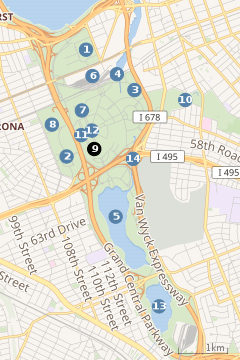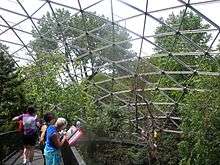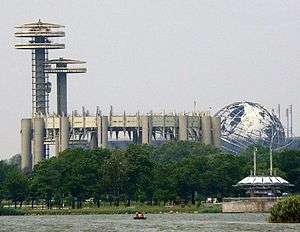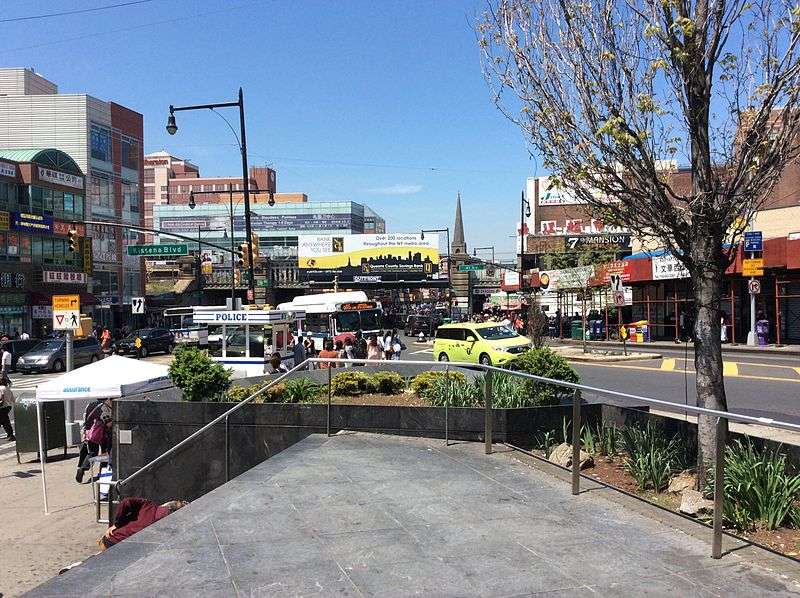Queens Zoo
The Queens Zoo is an 18-acre (7.3 ha) zoo located in Flushing Meadows–Corona Park in Queens, New York City. The zoo is part of an integrated system of four zoos and one aquarium managed by the Wildlife Conservation Society in partnership with the New York City Department of Parks and Recreation, and is accredited by the Association of Zoos and Aquariums (AZA).
Logo of Queens Zoo, part of the Wildlife Conservation Society | |
 Andean bear female at the zoo. | |
| Date opened | October 26, 1968 (as Flushing Meadow Zoo)[1] June 25, 1992 (as Queens Zoo)[2] |
|---|---|
| Location | Queens, New York, United States |
| Coordinates | 40.74374°N 73.848592°W |
| Land area | 18 acres (7.3 ha)[1] |
| No. of species | 75+[3] |
| Memberships | AZA[4] |
| Public transit access | Subway: Bus: Q23, Q48 LIRR: Port Washington Branch at Mets–Willets Point (limited service) |
| Website | www |
History
| Attractions and Geographical Features of Flushing Meadows–Corona Park |
 |
Attractions and geographical features of Flushing Meadows–Corona Park: 1 2 3 4 5 6 7 8 9 10 11 12 13 14 |

Constructed on the site of the 1964 New York World's Fair and opened in 1968, it is the first to be designed from the start as a cageless zoo. Robert Moses turned the first shovel full of earth for the new construction on August 20, 1966, and cut the ceremonial ribbon to the new 18-acre (7.3 ha) "Flushing Meadows Zoo" a bit more than two years later on October 26, 1968.[1][5]
The zoo's aviary is a geodesic dome designed by Thomas C. Howard of Synergetics, Inc. and used during the 1964 Fair.[2] The dome was originally designed as the fair's major indoor assembly hall, with no indoor supports blocking anyone's view, and repurposed for the 1965 season as a tribute to Winston Churchill after he died in 1964.[6] The 175-foot (53 m) diameter dome was one of the largest single-layer structures of its time. It was dismantled and stored after the fair, and was later reassembled in its current location with a mesh netting covering instead of the solid tent of the original dome.[7]
The zoo was closed in 1988 and reopened in 1992 after a four-year, $16 million renovation, redesign, and reconceptualization.[8]
Animals
The zoo is home to more than 75 species that are native to the Americas.[3] It is the only one of five zoos in New York City that exhibits Andean bears. The zoo is also home to: Pumas, California sea lions, coyotes, burrowing owls, Canadian lynxes, Southern pudús, thick-billed parrots, American alligators, Roosevelt elk, American bison, trumpeter swans, king vultures, pronghorns, sandhill cranes, bald eagles, great horned owls, Chacoan peccaries, a walk-through aviary, and a farm with a variety of domestic animals.[9]
References
- Asbury, Edith Evans (October 27, 1968). "Moses Helps to Open First Queens Zoo". nytimes.com. The New York Times. Retrieved May 21, 2012.
- "About the City Zoos". nyzoosandaquarium.com. Wildlife Conservation Society. Archived from the original on August 22, 2008. Retrieved May 20, 2012.
- "Animals and Exhibits". queenszoo.com. Wildlife Conservation Society. Archived from the original on May 29, 2012. Retrieved May 22, 2012.
- "Currently Accredited Zoos and Aquariums". aza.org. AZA. Retrieved May 27, 2010.
- Schumach, Murray (May 21, 2012). "Moses Gets Down to Earth in Opening World's Fair Site for Zoo". nytimes.com. The New York Times. Retrieved October 1, 2007.
- "World's Fair Building / Churchill Tribute". westland.net. Jeffrey Stanton. Retrieved May 21, 2012.
- Gray, Christopher (January 3, 1993). "Streetscapes: The Queens Aviary; A Great Outside Interior Space". nytimes.com. The New York Times. Retrieved July 16, 2016.
- Lyall, Sarah (October 22, 1993). "Zoo Story: A Q.-and-A. Stroll in Queens". nytimes.com. The New York Times. Retrieved June 11, 2009.
- "Zoo Map" (PDF). queenszoo.com. Wildlife Conservation Society. Archived from the original (PDF) on May 1, 2012. Retrieved May 22, 2012.
External links
| Wikimedia Commons has media related to Queens Zoo. |

